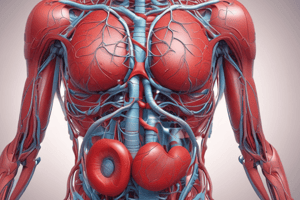Podcast
Questions and Answers
What is the primary aim of the cardiovascular module?
What is the primary aim of the cardiovascular module?
- To explore pharmacological treatments for heart diseases
- To study the history of cardiovascular research
- To understand the structure and function of the cardiovascular system (correct)
- To learn about emergency medical procedures
Which of the following statements best describes the role of blood in the cardiovascular system?
Which of the following statements best describes the role of blood in the cardiovascular system?
- Blood helps exchange substances through active transport
- Blood transports metabolic substrates, CO2, and waste products (correct)
- Blood's primary function is to maintain body temperature
- Blood only carries oxygen and nutrients to cells
Where does diffusion take place in the cardiovascular system?
Where does diffusion take place in the cardiovascular system?
- In the arteries and veins
- In the lymphatic system
- In the capillaries between blood and surrounding tissues (correct)
- In the heart chambers
What is the classification of the components of the cardiovascular system?
What is the classification of the components of the cardiovascular system?
What type of assessments will be included throughout the cardiovascular module?
What type of assessments will be included throughout the cardiovascular module?
What is the primary function of arterioles in the circulatory system?
What is the primary function of arterioles in the circulatory system?
Which organ has the lowest maximum blood flow according to the values provided?
Which organ has the lowest maximum blood flow according to the values provided?
In what way does gravity affect blood flow to the brain?
In what way does gravity affect blood flow to the brain?
What role does the left heart play in the circulation system?
What role does the left heart play in the circulation system?
What must be done to regulate blood flow to more difficult regions?
What must be done to regulate blood flow to more difficult regions?
What primarily defines the composition of capillaries?
What primarily defines the composition of capillaries?
In what way do lipophilic substances diffuse through capillaries?
In what way do lipophilic substances diffuse through capillaries?
Which factor does NOT affect the rate of diffusion?
Which factor does NOT affect the rate of diffusion?
What type of tissues would likely have a higher density of capillaries?
What type of tissues would likely have a higher density of capillaries?
What happens to the concentration gradient when tissues actively use a substance?
What happens to the concentration gradient when tissues actively use a substance?
The perfusion rate is defined as:
The perfusion rate is defined as:
Which substance typically diffuses through small pores in capillaries?
Which substance typically diffuses through small pores in capillaries?
How does the density of capillaries relate to the metabolic activity of tissues?
How does the density of capillaries relate to the metabolic activity of tissues?
What primarily maintains the concentration gradient between capillary blood and tissues?
What primarily maintains the concentration gradient between capillary blood and tissues?
What is a primary factor that contributes to diffusion resistance?
What is a primary factor that contributes to diffusion resistance?
Flashcards are hidden until you start studying
Study Notes
Module Structure
- Consists of introductory sessions covering the cardiovascular system, heart anatomy, and physiology.
- Final sessions focus on clinical applications and case studies.
- Includes group work and formative assessments at specified weeks.
Module Aim
- Understand the cardiovascular system's structure and function.
- Learn how to assess cardiovascular conditions.
- Explore how cardiovascular function is affected by common diseases.
Components of the Cardiovascular System
- Comprises three main parts:
- Distribution System: Vessels and blood.
- Pump: The heart.
- Exchange Mechanism: Capillaries facilitating substance exchange.
Blood Functions
- Transports oxygen, carbon dioxide, metabolic substrates, and waste products.
- Enables diffusion of substances between blood and body cells.
Diffusion Process
- Occurs primarily in capillaries, which are lined with endothelial cells.
- Lipophilic substances pass through lipid bilayers, while hydrophilic molecules use pores for transport.
- Movement occurs down concentration gradients.
Factors Affecting Diffusion
- Area: Larger area between capillaries and tissues enhances diffusion, with metabolically active tissues having more capillaries.
- Diffusion Resistance: Involves the nature of the molecule (lipophilic vs hydrophilic), barrier characteristics (pore size), and path length (determined by capillary density).
- Concentration Gradient: Greater differences in concentration accelerate diffusion; gradients must be maintained for ongoing exchange.
Blood Flow Requirements
- Blood flow must align with metabolic needs, increasing with higher metabolism.
- Perfusion Rate: The rate of blood flow essential for meeting tissue demands for oxygen and nutrients.
Blood Flow to Tissues
- Brain: Requires high, constant flow (0.5-1 g/ml.min).
- Heart Muscle: Flow increases during exercise (0.9-3.6 g/ml.min).
- Kidneys: High, stable flow (1 g/ml.min).
- Skeletal Muscle: Flow varies significantly during exercise (0.2-2.5 g/min).
- Gut: Blood flow increases post-meal (1.4-2.4 g/min).
Regulation of Blood Flow
- Requires resistance mechanisms to guide blood to demanding areas.
- Arterioles: Function as resistance vessels to control perfusion dynamics.
Heart Function
- Heart acts as two pumps:
- Right Heart: Pumps deoxygenated blood to the lungs (pulmonary circulation).
- Left Heart: Pumps oxygenated blood through systemic circulation.
Circulatory Pathway
- Blood flows from heart to arteries, then to arterioles, followed by capillary networks.
- Capillaries drain into venules, which lead to veins returning blood to the heart.
Studying That Suits You
Use AI to generate personalized quizzes and flashcards to suit your learning preferences.




